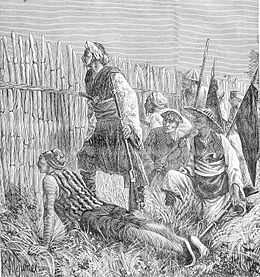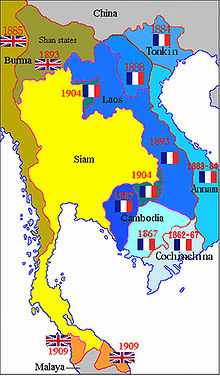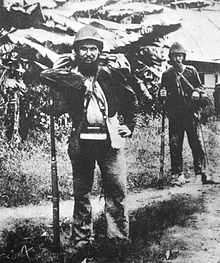Black Flag Army
The Black Flag Army (Chinese: 黑旗军; pinyin: Hēiqí Jūn; Vietnamese: Quân cờ đen) was a splinter remnant of a bandit group recruited largely from soldiers of ethnic Zhuang background, who crossed the border in 1865 from Guangxi, China into Upper Tonkin, then part of the Empire of Annam (Vietnam). Although brigands, they were known mainly for their fights against the invading French forces, who were then moving into Tonkin. With the sanction of both Vietnamese and Chinese authorities, the Black Flags joined the Vietnamese regular forces, stemming French encroachment beyond the Red River Delta. The Black Flag Army is so named because of the preference of its commander, Liu Yongfu, for using black command flags.
The rise and fall of the Black Flag Army

In 1857, Liu Yongfu (Vietnamese: Lưu Vĩnh Phúc), a Hakka soldier of fortune was heading a group of about 200 men within a larger bandit group of Guangxi province headed by Huang Sihong (黃思宏). He defected with his men to the band of Wu Yuanqing (Wu Yuan-ch'ing, 吳元清) under his own - black - flag. Liu organized a ceremony reminiscent of the tiandihui rituals and what will be known as the Black Flag Army was born. The "army" was operating as an independent unit under Wu Yuanqing and his son and successor, Wu Yazhong (Wu Ya-chung, 吳亞终) [1] or Wu Hezhong. Although not part of the Taiping forces, both Wu Yuanqing and Wu Yazhong laid claim to be Taiping "princes".
After the Taiping Rebellion was crushed in 1864 in Nanking, the Qing army proceeded to destroy systematically the many armed bands of south-eastern provinces, particularly the band of Wu Yazhong in Guangxi. Hotly pursued, the desperate Wu Yazhong, Liu and his Black Flag Army crossed into Upper Tonkin in 1865.
The Black Flags demonstrated their usefulness to the Vietnamese Court by helping the suppression of the indigenous tribes populating the mountainous terrain between the Red and Black Rivers, and for this Liu was rewarded with an official military title.
Secured with the backing of the Vietnamese Court, Liu Yongfu established a profitable extortion network along the course of the Red River, "taxing" river commerce between Sơn Tây and Lào Cai at a rate of 10%. The profits accrued from this venture were so great that Liu's army swelled in numbers in the 1870s, attracting to its ranks adventurers from all over the world. Although most of the Black Flag soldiers were Chinese, among the junior officers there were American and European soldiers of fortune, some of whom had seen action in the Taiping Rebellion. Liu used their expertise to transform the Black Flag Army into a formidable fighting force. Under his command in Tonkin, there were 7,000 soldiers from Guangdong and Guangxi.[2]
The harassment of European vessels trading on the Red River triggered the dispatch of the French expeditionary force to Tonkin under Commandant Henri Rivière in 1882. The resulting clashes between the French and the Black Flag Army (the latter abetted by the regular Vietnamese and Chinese forces) escalated, resulting eventually in the Sino-French War (August 1884-April 1885). The Black Flags assisted the Chinese forces during this war, best known in the fierce Siege of Tuyên Quang when the joint Black Flags-Chinese armies holed up a battalion of the French Foreign Legion defending the citadel. The Black Flag Army was formally disbanded at the end of the Sino-French War, though many of its members continued to harass the French for years afterward as freelance bandits.
Remarkably, the Black Flag Army was called into being again in 1895 by Liu Yongfu in response to the Japanese invasion of Taiwan (1895). Liu Yongfu crossed to Taiwan at the appeal of his old friend Tang Ching-sung, island's former governor-general and now president of the short-lived Republic of Formosa. Liu was to command the Formosan resistance forces against the Japanese. Liu took a number of aging Black Flag veterans back into service to join the fight against the Japanese, but the reconstituted Black Flag Army was swept aside with ease by the Japanese Imperial Guards Division. Liu himself was obliged to disguise himself as an old woman to escape capture.
The Black Flag Army in action
Defeat of Francis Garnier's invasion of Tonkin, December 1873

In 1873 the Vietnamese government enlisted the help of the Black Flag Army to defeat the first French attempt to conquer Tonkin, led by the naval lieutenant Francis Garnier. On 21 December 1873 Liu Yongfu and around 600 Black Flags (French: pavillons noirs, drapeaux noirs), marching beneath an enormous black banner, approached the west gate of the Hanoi Citadel. A large Vietnamese army followed in their wake. Garnier ordered the shelling of the Black Flags with a field piece mounted above the gate, and when they were repulsed, he led a party of 18 French marine infantrymen out of the gate in pursuit. Garnier and three of his men charged uphill in a bayonet attack on a party of Black Flags but was speared to death after stumbling in a watercourse. The youthful enseigne de vaisseau Adrien-Paul Balny d’Avricourt led a similar small column to reinforce Garnier but was also killed in front of his men. Three other French soldiers were killed in these sorties, and the others fled back to the citadel after their officers fell. Garnier's death shocked the French public and ended the first French adventure in Tonkin.[3]
Defeat of Henri Rivière's invasion of Tonkin, May 1883
Ten years later, with France again pushing into Tonkin, undeclared hostilities broke out in 1883 and the first half of 1884 as a prelude to the Sino-French War. The Black Flags fought several engagements against French forces in Tonkin. The first major clash was at the Battle of Paper Bridge (19 May 1883), in which the French naval captain Henri Rivière was ambushed and killed. It was a swift and striking victory for the Black Flag Army.[4]
Indecisive clashes, summer 1883
In the Battle of Phủ Hoài (15 August 1883, the Black Flag Army successfully defended its positions against a French attack launched by General Alexandre-Eugène Bouët, though it took considerably higher casualties than the French.[5] In the Battle of Palan (1 September 1883) the Black Flags did less well, being driven from a key position on the River Đáy.[6]
Disaster at Sơn Tây, December 1883
In December 1883 the Black Flag Army suffered a major defeat at the hands of Admiral Amédée Courbet in the Sơn Tây Campaign. Despite fighting with fanatical courage in the engagements at Phu Sa on 14 December and Son Tay on 16 December, the Black Flags were unable to prevent the French from storming Sơn Tây. Even with large Chinese and Vietnamese regular contingents at Son Tay, the Black Flag Army bore the brunt of the fighting, and took very heavy casualties. In the opinion of the British observer William Mesny, a senior officer in the Chinese army, the fighting at Sơn Tây broke the power of the Black Flag Army, though the stubborn defence put up by the Black Flags in the Battle of Hòa Mộc fifteen months later does not bear out this assessment.[7]
Loss of Hưng Hóa, April 1884
The Black Flag Army took no part in the Bắc Ninh Campaign (March 1884). After the French capture of Bac Ninh, the Black Flags retreated to Hưng Hóa. In April 1884 the French advanced on Hưng Hóa with both brigades of the Tonkin Expeditionary Corps. The Black Flags had thrown up an impressive series of fortifications around the town, but General Charles-Théodore Millot, the French commander-in-chief, took it without a single French casualty. While General François de Négrier's 2nd Brigade pinned the Black Flags frontally from the east and subjected Hung Hoa to a ferocious artillery bombardment from the Trung Xa heights, General Louis Brière de l'Isle's 1st Brigade made a flank march to the south to cut Liu's line of retreat. On the evening of 11 April, seeing Brière de l'Isle's Turcos and marine infantry emerging behind their flank at Xuan Dong, the Black Flags evacuated Hung Hoa before they were trapped inside it. They set alight the remaining buildings before they left, and on the following morning the French found the town completely abandoned.[8]
Loss of Tuyen Quang, June 1884
The Black Flag Army retreated up the Red River to Thanh Quan, only a few days march from the frontier town of Lào Cai. Several hundred Black Flag soldiers, demoralised by the ease with which Courbet and Millot had defeated the Black Flag Army, surrendered to the French in the summer of 1884. One of Millot's final achievements was to advance up the Clear River and throw the Black Flag Army out of Tuyên Quang in the first week of June, again without a single French casualty. If the French had seriously pursued Liu Yongfu after the capture of Tuyên Quang, the Black Flags would probably have been driven from Tonkin there and then. But French attention was diverted by the sudden crisis with China provoked by the Bắc Lệ ambush (23 June 1884), and during the eventful summer of 1884 the Black Flags were left to lick their wounds.[9]
Alliance with the Chinese, September 1884 to April 1885
The fortunes of the Black Flag Army were transformed by the outbreak of the Sino-French War in August 1884. The Empress Dowager Cixi responded to the news of the destruction of China's Fujian Fleet at the Battle of Fuzhou (23 August 1884) by ordering her generals to invade Tonkin to throw the French out of Hanoi. Tang Ching-sung, the commander of the Yunnan Army, knew that Liu's services would be invaluable in the war with France, and Liu agreed to take part with the Black Flag Army in the forthcoming campaign. The Black Flags helped the Chinese forces put pressure on Hung Hoa and the isolated French posts of Phu Doan and Tuyen Quang during the autumn of 1884.
The battle of Hòa Mộc, March 1885


In the winter and spring of 1885 3,000 soldiers of the Black Flag Army served during the Siege of Tuyên Quang. At the Battle of Hòa Mộc (2 March 1885), the Black Flag Army inflicted heavy casualties on a French column marching to the relief of Tuyên Quang. French casualties at Hòa Mộc were 76 dead and 408 wounded, the highest casualty rate and the heaviest loss in a single day's fighting sustained by the French during the Sino-French War. Many French officers at Hòa Mộc said that the carnage was even worse than at Sơn Tây fifteen months earlier.[10]
Disbandment of the Black Flag Army, June 1885
One of the conditions of the peace treaty between France and China that ended the Sino-French War was that Liu Yongfu should leave Tonkin. By the end of the war Liu had only around 2,000 troops under his command and was in no position to resist pressure from Tang Ching-sung and the other commanders of the Yunnan Army to remove the Black Flag Army. Liu crossed into China with some of his most loyal followers, but the bulk of the Black Flag Army was disbanded on Tonkinese soil in the summer of 1885. Unpaid for months and still in possession of their rifles, most of the unwanted Black Flag soldiers immediately took to banditry, under cover of the Cần Vương resistance movement against the French. It took months for the French to reduce them, and the route between Hung Hoa and the border town of Lao Cai was only secured in February 1886. In 1887, Black Flag bandits remained sufficiently powerful to ransack and pillage Luang Prabang.
Flags of the Black Flag Army

Liu Yongfu evidently had a personal preference for the colour black, having dreamt in his youth that he would one day become a 'general of the black tiger'. The Black Flag Army is named from the colour of Liu's command flags.[11]
French sources invariably mention that Liu Yongfu's personal command flags were very large, black in colour, and rectangular. In December, 1873, when Liu Yongfu confronted Francis Garnier outside Hanoi, the Black Flag Army was described as marching under enormous black flags. At the Battle of Palan (September 1, 1883), Liu Yongfu's headquarters was marked with seven identical black flags, bordered in silver. In the Sơn Tây Campaign (December, 1883), Liu Yongfu ordered three large black flags to be flown above the main gate of the citadel of Sơn Tây, bearing Chinese characters in white.
Individual Black Flag units flew a variety of flags, some rectangular and others triangular. In the afternoon of August 15, 1883, during the Battle of Phủ Hoài, several units of the Black Flag Army emerged from their defences and advanced across open ground to attack the French left wing; according to a French eyewitness, the advancing Black Flag units bore numerous black banners decorated with Chinese characters in either red or white.[12]
Surviving Black Flag banners include a black triangular banner with a representation in white of the seven stars of the Great Bear.
Notes
 This article incorporates text from China: A collection of correspondence and papers relating to Chinese affairs, by Great Britain. Foreign Office, a publication from 1885 now in the public domain in the United States.
This article incorporates text from China: A collection of correspondence and papers relating to Chinese affairs, by Great Britain. Foreign Office, a publication from 1885 now in the public domain in the United States.
- ↑ also known under other names, such as Wu Azhong (Wu Ah-chung, 吳阿忠) as in McAleavy, 1968.
- ↑ Great Britain. Foreign Office (1885). China: A collection of correspondence and papers relating to Chinese affairs. LONDON. p. 29. Retrieved 2011-06-09.(Original from Harvard University)
- ↑ Thomazi, Conquête, 126–8
- ↑ Thomazi, Conquête, 152–7
- ↑ Thomazi, Conquête, 162–5
- ↑ Thomazi, Conquête, 166–7
- ↑ Huard, 180–7 and 202–31; Thomazi, Conquête, 171–7; Histoire militaire, 68–72
- ↑ Huard, 280–90; Thomazi, Histoire militaire, 84
- ↑ Thomazi, Histoire militaire, 85–7
- ↑ Thomazi, Conquête, 247–8; Histoire militaire, 107–8
- ↑ McAleavy, 102 and 105
- ↑ Duboc, 174
3^ >>
References
| Wikimedia Commons has media related to Black Flag Army. |
- Duboc, E., Trente cinq mois de campagne en Chine, au Tonkin (Paris, 1899)
- Forbes, Andrew, and Henley, David: Vietnam Past and Present: The North (Chapter on Liu Yungfu and the Black Flags in Tonkin). Chiang Mai. Cognoscenti Books, 2012. ASIN: B006DCCM9Q.
- Huard, L., La guerre du Tonkin (Paris, 1887)
- Lung Chang [龍章], Yueh-nan yu Chung-fa chan-cheng [越南與中法戰爭, Vietnam and the Sino-French War] (Taipei, 1993)
- McAleavy, H., Black Flags in Vietnam: The Story of a Chinese Intervention (New York, 1968)
- Thomazi, A., La conquête de l'Indochine (Paris, 1934)
- Thomazi, A., Histoire militaire de l'Indochine français (Hanoi, 1931)
See also
| |||||||||||||||||||
| ||||||||||||||||||||||




